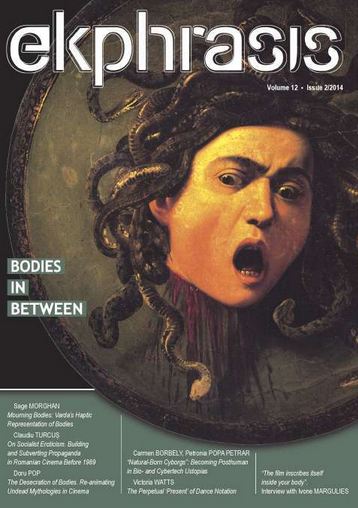A New Look on Ekphrasis: an Eye-tracking Experiment on a Cinematic Example
A New Look on Ekphrasis: an Eye-tracking Experiment on a Cinematic Example
Author(s): Liviu Lutas, Alexander Strukelj, Carla Cariboni-KillanderSubject(s): Theatre, Dance, Performing Arts
Published by: Universitatea Babeş-Bolyai, Facultatea de Teatru si Televiziune
Keywords: Ekphrasis; enargeia; cinema; Barbara; Pethö; Yacobi; Elleström; media representation; intermediality; description
Summary/Abstract: Taking the modern definition of ekphrasis as a verbal representation of a work of art as a starting point, we try to broaden it in this contribution. We agree with intermediality theorist Lars Elleström that ekphrasis falls into the category of “media representation”, defined as the representation of a source medium in a target medium. We argue that the target medium does not need to be a verbal one and what matters is the energeia, the vividness of the description, leading in turn to enargeia, a vivid image in the mind of the receiver. The energeia-enargeia relation is an aspect that is often neglected in modern theoretical debates about ekphrasis. We believe that there cannot be ekphrasis without a description making the receiver “see” the object with his/her inner eye. At the same time, following Seymour Chatman and Werner Wolf, we argue that description is not a prerogative of the verbal medium and that even the cinematic medium can describe, using different strategies. In the second part of this contribution, these hypotheses are tested empirically with the help of the eye-tracking technique. A short sequence of Christian Petzold’s film Barbara (2012), which constitutes an example of cinematic ekphrasis, is shown to thirty-three participants. The evidence gathered from the recording of their eye-movements confirms the relevance of the energeia-enargeia relation: the eye activity increases at some particular points of the sequence, points corresponding to the descriptive activity of the camera. Ekphrasis is thus a kind of embodied experience.
Journal: Ekphrasis. Images, Cinema, Theory, Media
- Issue Year: 12/2014
- Issue No: 2
- Page Range: 10-31
- Page Count: 22

